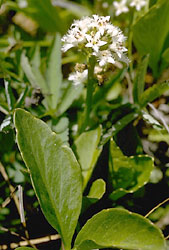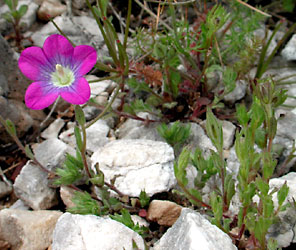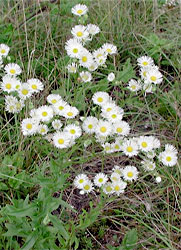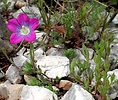Asterales
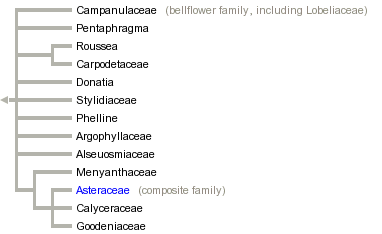


This tree diagram shows the relationships between several groups of organisms.
The root of the current tree connects the organisms featured in this tree to their containing group and the rest of the Tree of Life. The basal branching point in the tree represents the ancestor of the other groups in the tree. This ancestor diversified over time into several descendent subgroups, which are represented as internal nodes and terminal taxa to the right.

You can click on the root to travel down the Tree of Life all the way to the root of all Life, and you can click on the names of descendent subgroups to travel up the Tree of Life all the way to individual species.
For more information on ToL tree formatting, please see Interpreting the Tree or Classification. To learn more about phylogenetic trees, please visit our Phylogenetic Biology pages.
close boxReferences
Albach, D. C., P. S. Soltis, D. E. Soltis, and R. G. Olmstead. 2001. Phylogenetic analysis of asterids based on sequences of four genes. Annals of the Missouri Botanical Garden 88:163-212.
Backlund, A. and B. Bremer. 1997. Phylogeny of Asteridae s. str. based on rbcL sequences, with particular reference to Dipsacales. Plant Systematics and Evolution 207:225-254.
Bremer, K. 1994. Asteraceae: Cladistics and Classification. Timber Press, Portland, Oregon.
Bremer, K., A. Backlund, B. Sennblad, U. Swenson, K. Andreasen, M. Hjertson, J. Lundberg, M. Backlund, and B. Bremer. 2001. A phylogenetic analysis of 100+ genera and 50+ families of euasterids based on morphological and molecular data with notes on possible higher level morphological synapomorphies. Plant Systematics and Evolution 229:137-169.
Bremer, B., K. Bremer, N. Heidari, P. Erixon, R. G. Olmstead, A. A. Anderberg, M. K�llersj�, and E. Barkhordarian. 2002. Phylogenetics of asterids based on 3 coding and 3 non-coding chloroplast DNA markers and the utility of non-coding DNA at higher taxonomic levels. Molecular Phylogenetics and Evolution 24:274-301.
Bremer, K. and M. H. G. Gustafsson. 1997. East Gondwana ancestry of the sunflower alliance of families. Proceedings of the National Academy of Sciences (USA) 94:9188-9190.
Gustafsson, M. H. G., A. Backlund, and B. Bremer. 1996. Phylogeny of the Asterales sensu late based on rbcL sequences with particular reference to the Goodeniaceae. Plant Systematics and Evolution 199:217-242.
Gustafsson, M. H. G. and K. Bremer. 1995. Morphology and Phylogenetic Interrelationships of the Asteraceae, Calyceraceae, Campanulaceae, Goodeniaceae, and Related Families (Asterales). American Journal of Botany 82:250-265.
Karehed, J., J. Lundberg, B. Bremer, and K. Bremer. 1999. Evolution of the Australasian families Alseuosmiaceae, Argophyllaceae, and Phellinaceae. Systematic Botany 24:660-682.
Lammers, T. G. 1992. Circumscription and phylogeny of the Campanulales. Annals of the Missouri Botanical Garden 79:388-413.
Lundberg, J. 2001. The asteralean affinity of the Mauritian Roussea (Rousseaceae). Botanical Journal of the Linnean Society 137:267-276.
Lundberg J. and K. Bremer. 2003. A phylogenetic study of the order Asterales using one morphological and three molecular data sets. International Journal of Plant Science 164:553-578.
Olmstead, R. G., K.-J. Kim, R. K. Jansen, and S. J. Wagstaff. 2000. The phylogeny of the Asteridae sensu lato based on chloroplast ndhF gene sequences. Molecular Phylogenetics and Evolution 16:96-112.
Savolainen, V., M. F. Fay, D. C. Albach, A. Backlund, M. van der Bank, K. M. Cameron, S. A. Johnson, M. D. Lled�, J.-C. Pintaud, M. Powell, M. C. Sheahan, D. E. Soltis, P. S. Soltis, P. Weston, W. M. Whitten, K. J. Wurdack, and M. W. Chase. 2000. Phylogeny of the eudicots: a nearly complete familial analysis based on rbcl gene sequences. Kew Bulletin 55:257-309.
Soltis, D. E., P. S. Soltis, M. W. Chase, M. E. Mort, D. C. Albach, M. Zanis, V. Savolainen, W. H. Hahn, S. B. Hoot, M. F. Fay, M. Axtell, S. M. Swensen, L. M. Prince, W. J. Kress, K. C. Nixon, and J. S. Farris. 2000. Angiosperm phylogeny inferred from 18S rDNA, rbcL, and atpB sequences. Botanical Journal of the Linnean Society 133:381-461.
Tobe, H. and N. R. Morin. 1996. Embryology and circumscription of Campanulaceae and Campanulales: A review of literature. Journal of Plant Research 109:425-435.
Title Illustrations
| Scientific Name | Menyanthes trifoliata |
|---|---|
| Comments | Menyanthaceae |
| Creator | Photograph by Gladys Lucille Smith |
| Acknowledgements | courtesy CalPhotos |
| Copyright | © 1999 California Academy of Sciences |
| Scientific Name | Legousia pentagonia |
|---|---|
| Location | Samos, Greece |
| Comments | Campanulaceae |
| Acknowledgements | courtesy Botanical Image Database |
| Copyright | © 2001 University of Basel |
| Scientific Name | Erigeron annuus |
|---|---|
| Location | Sevelen SG, Switzerland |
| Comments | Asteraceae |
| Acknowledgements | courtesy Botanical Image Database |
| Copyright | © 2001 University of Basel |





